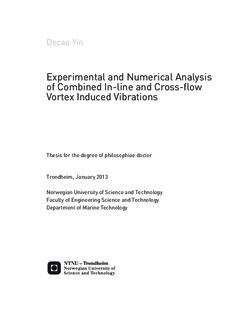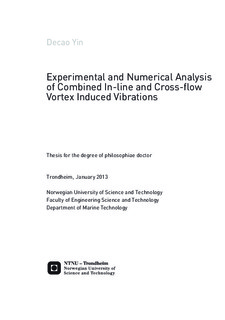| dc.contributor.advisor | Larsen, Carl M. | nb_NO |
| dc.contributor.author | Yin, Decao | nb_NO |
| dc.date.accessioned | 2014-12-19T14:50:22Z | |
| dc.date.available | 2014-12-19T14:50:22Z | |
| dc.date.created | 2013-01-25 | nb_NO |
| dc.date.issued | 2013 | nb_NO |
| dc.identifier | 600709 | nb_NO |
| dc.identifier.isbn | 978-82-471-4138-0 | nb_NO |
| dc.identifier.isbn | 978-82-471-4136-6 (printed version) | nb_NO |
| dc.identifier.uri | http://hdl.handle.net/11250/273121 | |
| dc.description.abstract | This thesis presents results from experimental and numerical investigations of the hydrodynamic forces on a rigid cylinder moving with prescribed orbits in uniform flow. The hydrodynamic forces are measured in both in-line (IL) and cross- ow (CF) directions. The measurements are processed to nd excitation and added mass coeffcients at discrete frequencies. The numerical simulations are used to illustrate the vortex shedding modes and are compared with the experimental results.
The hydrodynamic coeffcients obtained from the harmonic forced motion experiments of a rigid cylinder do not always represent forces on a cross section of a exible beam. The orbits used in the forced motion experiments are therefore extracted from the measured motions of cross sections of a exible pipe under uniform and shear flows. Both periodic and observed orbits within a time window are applied as prescribed motions. Higher order displacement components are present in such orbits.
IL response amplitudes from combined IL and CF response are larger than pure IL response amplitudes. The hydrodynamic coefficients obtained from the periodic experiments are often larger than those obtained from the pure IL tests. Higher order displacement components are more common in the IL direction than in the CF direction, and higher order IL displacement components will cause larger hydrodynamic forces in both directions. The hydrodynamic coefficients obtained from periodic motion tests are adequate for representing quasi-periodic observed motions. For chaotic observed motions, periodic orbits will yield hydrodynamic coefficients with larger uncertainties.
Results from numerical analyses using large eddy simulation (LES) indicate that this method can be used to identify vortex shedding patterns and predict hydrodynamic forces under certain Re numbers and orbits. | nb_NO |
| dc.language | eng | nb_NO |
| dc.publisher | NTNU | nb_NO |
| dc.relation.ispartofseries | Doctoral Theses at NTNU, 1503-8181; 2013:23 | nb_NO |
| dc.subject | Vortex induced vibration | en_GB |
| dc.subject | hydrodynamic force | en_GB |
| dc.title | Experimental and Numerical Analysis of Combined In-line and Cross-flow Vortex Induced Vibration | nb_NO |
| dc.type | Doctoral thesis | nb_NO |
| dc.source.pagenumber | 251 | nb_NO |
| dc.contributor.department | Norges teknisk-naturvitenskapelige universitet, Senter for fremragende forskning, Centre for Ships and Ocean Structures | nb_NO |
| dc.description.degree | PhD i marin teknikk | nb_NO |
| dc.description.degree | PhD in Marine Technology | en_GB |

